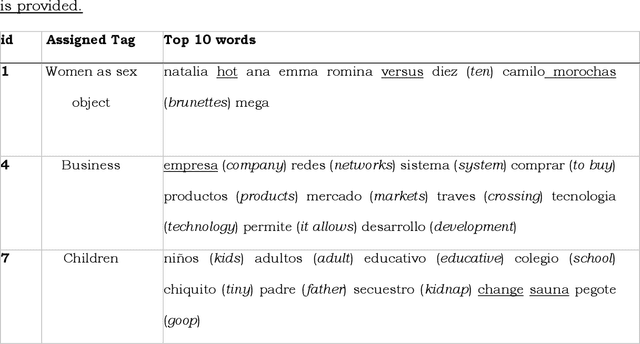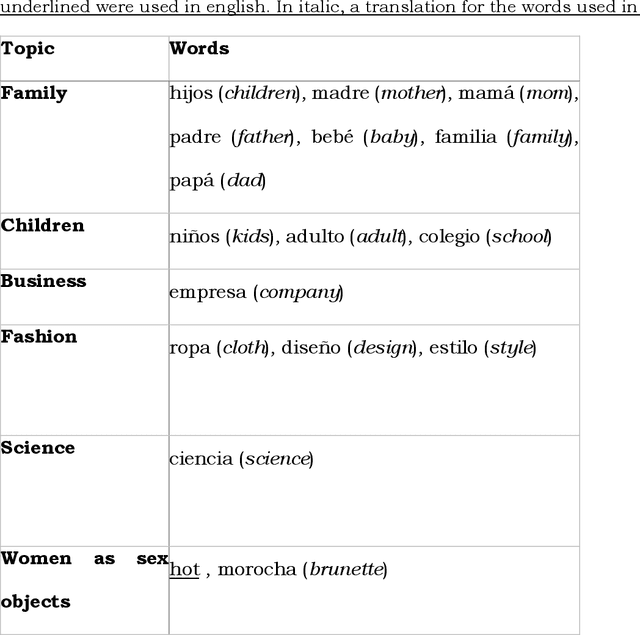Diego Kozlowski
CLIRudit: Cross-Lingual Information Retrieval of Scientific Documents
Apr 22, 2025Abstract:Cross-lingual information retrieval (CLIR) consists in finding relevant documents in a language that differs from the language of the queries. This paper presents CLIRudit, a new dataset created to evaluate cross-lingual academic search, focusing on English queries and French documents. The dataset is built using bilingual article metadata from \'Erudit, a Canadian publishing platform, and is designed to represent scenarios in which researchers search for scholarly content in languages other than English. We perform a comprehensive benchmarking of different zero-shot first-stage retrieval methods on the dataset, including dense and sparse retrievers, query and document machine translation, and state-of-the-art multilingual retrievers. Our results show that large dense retrievers, not necessarily trained for the cross-lingual retrieval task, can achieve zero-shot performance comparable to using ground truth human translations, without the need for machine translation. Sparse retrievers, such as BM25 or SPLADE, combined with document translation, show competitive results, providing an efficient alternative to large dense models. This research advances the understanding of cross-lingual academic information retrieval and provides a framework that others can use to build comparable datasets across different languages and disciplines. By making the dataset and code publicly available, we aim to facilitate further research that will help make scientific knowledge more accessible across language barriers.
Sorting the Babble in Babel: Assessing the Performance of Language Detection Algorithms on the OpenAlex Database
Feb 05, 2025Abstract:Following a recent study on the quality of OpenAlex linguistic metadata (C\'espedes et al., 2025), the present paper aims to optimize the latter through the design, use, and evaluation of various linguistic classification procedures based on the latest and most efficient automatic language detection algorithms. Starting from a multilingual set of manually-annotated samples of articles indexed in the database, different classification procedures are then designed, based on the application of a set of language detection algorithms on a series of corpora generated from different combinations of textual metadata of indexed articles. At sample level first, the performance of these different procedures for each of the main languages in the database is evaluated in terms of precision, recall, and processing time. Then, overall procedure performance is estimated at the database level by means of a probabilistic simulation of harmonically aggregated and weighted scores. Results show that procedure performance strongly depends on the importance given to each of the measures implemented: for contexts where precision is preferred, using the LangID algorithm on article titles, abstracts as well as journal names gives the best results; however, for all cases where recall is considered at least slightly more important than precision or as soon as processing times are given any kind of consideration, use of the FastSpell algorithm on article titles only outperforms all other alternatives. Given the lack of truly multilingual, large-scale bibliographic databases, it is hoped that these results help confirm and foster the unparalleled potential of the OpenAlex database for cross-linguistic, bibliometric-based research and analysis.
Delineating Feminist Studies through bibliometric analysis
Nov 27, 2024Abstract:The multidisciplinary and socially anchored nature of Feminist Studies presents unique challenges for bibliometric analysis, as this research area transcends traditional disciplinary boundaries and reflects discussions from feminist and LGBTQIA+ social movements. This paper proposes a novel approach for identifying gender/sex related publications scattered across diverse scientific disciplines. Using the Dimensions database, we employ bibliometric techniques, natural language processing (NLP) and manual curation to compile a dataset of scientific publications that allows for the analysis of Gender Studies and its influence across different disciplines. This is achieved through a methodology that combines a core of specialized journals with a comprehensive keyword search over titles. These keywords are obtained by applying Topic Modeling (BERTopic) to the corpus of titles and abstracts from the core. This methodological strategy, divided into two stages, reflects the dynamic interaction between Gender Studies and its dialogue with different disciplines. This hybrid system surpasses basic keyword search by mitigating potential biases introduced through manual keyword enumeration. The resulting dataset comprises over 1.9 million scientific documents published between 1668 and 2023, spanning four languages. This dataset enables a characterization of Gender Studies in terms of addressed topics, citation and collaboration dynamics, and institutional and regional participation. By addressing the methodological challenges of studying "more-than-disciplinary" research areas, this approach could also be adapted to delineate other conversations where disciplinary boundaries are difficult to disentangle.
Generative AI for automatic topic labelling
Aug 13, 2024



Abstract:Topic Modeling has become a prominent tool for the study of scientific fields, as they allow for a large scale interpretation of research trends. Nevertheless, the output of these models is structured as a list of keywords which requires a manual interpretation for the labelling. This paper proposes to assess the reliability of three LLMs, namely flan, GPT-4o, and GPT-4 mini for topic labelling. Drawing on previous research leveraging BERTopic, we generate topics from a dataset of all the scientific articles (n=34,797) authored by all biology professors in Switzerland (n=465) between 2008 and 2020, as recorded in the Web of Science database. We assess the output of the three models both quantitatively and qualitatively and find that, first, both GPT models are capable of accurately and precisely label topics from the models' output keywords. Second, 3-word labels are preferable to grasp the complexity of research topics.
Avoiding bias when inferring race using name-based approaches
May 03, 2021



Abstract:Racial disparity in academia is a widely acknowledged problem. The quantitative understanding of racial-based systemic inequalities is an important step towards a more equitable research system. However, few large-scale analyses have been performed on this topic, mostly because of the lack of robust race-disambiguation algorithms. Identifying author information does not generally include the author's race. Therefore, an algorithm needs to be employed, using known information about authors, i.e., their names, to infer their perceived race. Nevertheless, as any other algorithm, the process of racial inference can generate biases if it is not carefully considered. When the research is focused on the understanding of racial-based inequalities, such biases undermine the objectives of the investigation and may perpetuate inequities. The goal of this article is to assess the biases introduced by the different approaches used name-based racial inference. We use information from US census and mortgage applications to infer the race of US author names in the Web of Science. We estimate the effects of using given and family names, thresholds or continuous distributions, and imputation. Our results demonstrate that the validity of name-based inference varies by race and ethnicity and that threshold approaches underestimate Black authors and overestimate White authors. We conclude with recommendations to avoid potential biases. This article fills an important research gap that will allow more systematic and unbiased studies on racial disparity in science.
Gender bias in magazines oriented to men and women: a computational approach
Nov 24, 2020



Abstract:Cultural products are a source to acquire individual values and behaviours. Therefore, the differences in the content of the magazines aimed specifically at women or men are a means to create and reproduce gender stereotypes. In this study, we compare the content of a women-oriented magazine with that of a men-oriented one, both produced by the same editorial group, over a decade (2008-2018). With Topic Modelling techniques we identify the main themes discussed in the magazines and quantify how much the presence of these topics differs between magazines over time. Then, we performed a word-frequency analysis to validate this methodology and extend the analysis to other subjects that did not emerge automatically. Our results show that the frequency of appearance of the topics Family, Business and Women as sex objects, present an initial bias that tends to disappear over time. Conversely, in Fashion and Science topics, the initial differences between both magazines are maintained. Besides, we show that in 2012, the content associated with horoscope increased in the women-oriented magazine, generating a new gap that remained open over time. Also, we show a strong increase in the use of words associated with feminism since 2015 and specifically the word abortion in 2018. Overall, these computational tools allowed us to analyse more than 24,000 articles. Up to our knowledge, this is the first study to compare magazines in such a large dataset, a task that would have been prohibitive using manual content analysis methodologies.
Semantic and Relational Spaces in Science of Science: Deep Learning Models for Article Vectorisation
Nov 05, 2020



Abstract:Over the last century, we observe a steady and exponentially growth of scientific publications globally. The overwhelming amount of available literature makes a holistic analysis of the research within a field and between fields based on manual inspection impossible. Automatic techniques to support the process of literature review are required to find the epistemic and social patterns that are embedded in scientific publications. In computer sciences, new tools have been developed to deal with large volumes of data. In particular, deep learning techniques open the possibility of automated end-to-end models to project observations to a new, low-dimensional space where the most relevant information of each observation is highlighted. Using deep learning to build new representations of scientific publications is a growing but still emerging field of research. The aim of this paper is to discuss the potential and limits of deep learning for gathering insights about scientific research articles. We focus on document-level embeddings based on the semantic and relational aspects of articles, using Natural Language Processing (NLP) and Graph Neural Networks (GNNs). We explore the different outcomes generated by those techniques. Our results show that using NLP we can encode a semantic space of articles, while with GNN we are able to build a relational space where the social practices of a research community are also encoded.
 Add to Chrome
Add to Chrome Add to Firefox
Add to Firefox Add to Edge
Add to Edge